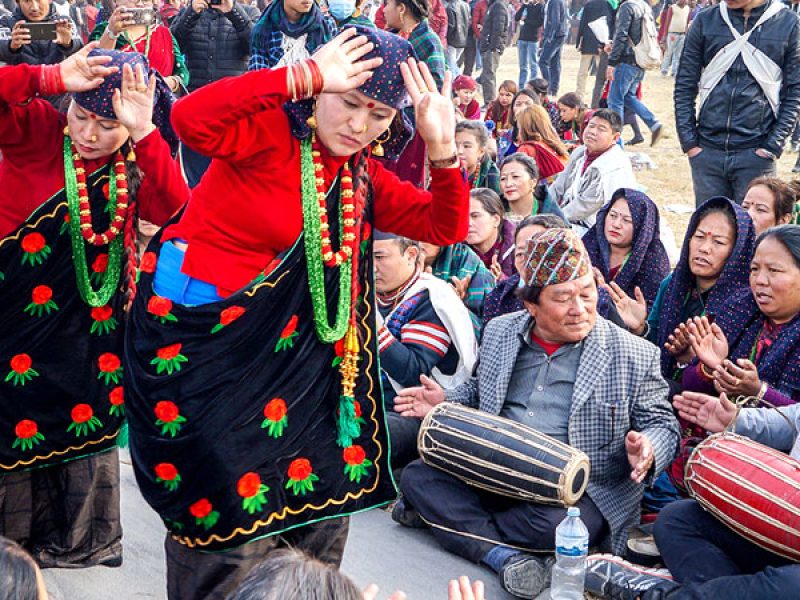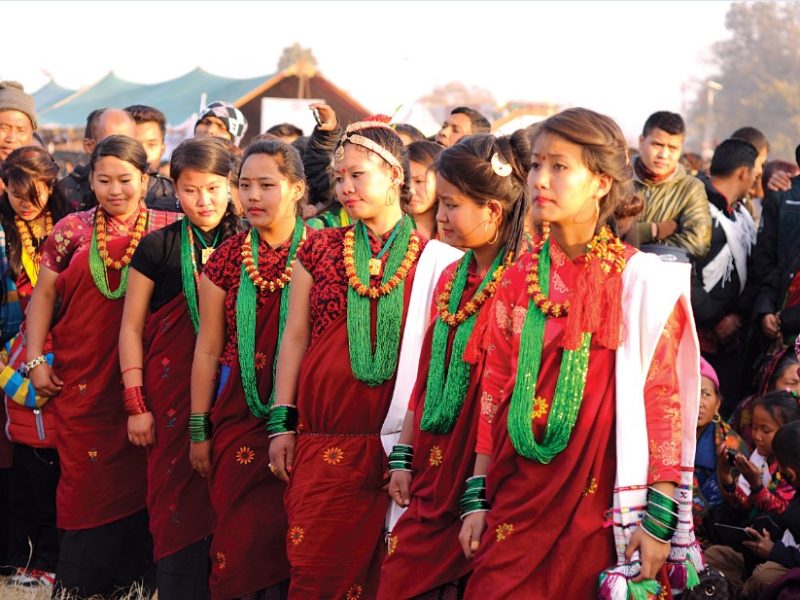Celebrate Nepal’s Tamu Lhosar Festival, honoring the Gurung New Year and their lively culture with joy and unity. Nepal is known as the “Roof of the World” which is a land of diverse cultures and rich traditions. The Tamu Lhosar Festival is celebrated by the Gurung community, is a vibrant event marking the beginning of the Gurung New Year.
The festival is a time-honored tradition that binds generations together and reaffirms their collective identity. Preparation for the festival begins weeks in advance, with families cleaning their homes, decorating them with colorful motifs and traditional artwork.
On the day of the festival, communities come alive with joyous celebrations, including the Chandi Dance and the Ghatu Dance, which symbolize the cycle of life, death, and rebirth. Food plays a central role in the festivities, with families sharing traditional dishes and delicacies.
Significance Of The Tamu Lhosar Festival For Gurung People
Firstly, the Tamu Lhosar Festival is celebrated in December or January which is a significant event for the Gurung people. It is an indigenous ethnic group in Nepal known for their bravery, resilience, and vibrant culture.
The importance of the Tamu Lhosar Festival for gurung people are listed below:
- This festival, meaning “New Year” in Tibetan, deeply reflects the Gurung community’s history, culture, and spiritual beliefs.
- Originating from ancient times, it pays homage to deities, spirits, and ancestors thought to influence the natural world, fostering a profound connection to the divine.
- Alongside spiritual aspects, the festival plays a vital role in preserving Gurung cultural identity and heritage, showcasing traditional dances, music, attire, and cuisine.
- Moreover, it facilitates social cohesion and unity within the community, promoting reconciliation and understanding among individuals from diverse backgrounds.
- Furthermore, it also encourages cultural exchange and interaction with other ethnic groups in Nepal, often featuring interethnic gatherings.
- Overall, the Tamu Lhosar Festival serves as a powerful expression of the Gurung people’s spiritual beliefs, cultural heritage, and sense of community.
- Through celebration, they honor their past, embrace the present, and anticipate the future with optimism and hope.
Traditions And Celebrations At The Tamu Lhosar Festival
The Tamu Lhosar Festival in Nepal is a celebration of the rich cultural heritage of the Gurung community. It is characterized by the Chandi Dance, a ritualistic dance performed to honor Chandi, a warrior goddess symbolizing strength, protection, and prosperity.
Participants wear elaborate costumes and dance to the rhythm of traditional music, seeking blessings for their community’s well-being. Similarly, the Ghatu Dance is another integral part of the festival which is a vibrant display of Gurung culture. It is performed by groups of dancers, both young and old, celebrating the harvest season and nature’s bounty.

For instance, traditional attire and ornaments are a key aspect of the festival, with participants wearing vibrant colors, intricate patterns, and embroidery. These costumes and ornaments serve as symbols of cultural pride and heritage for the Gurung community.
Cultural performances and rituals, such as folk songs, storytelling sessions, martial arts demonstrations, and religious ceremonies, also showcase the diversity of Gurung traditions. Community feasting and hospitality are central to the festival, with families and communities sharing traditional dishes and delicacies.
This fosters unity, generosity, and hospitality among community members, reinforcing social bonds and promoting unity within the Gurung community. Thus this festival symbolizes the spirit of tradition, community, and celebration that lies at the heart of Gurung culture.
The Tamu Lhosar Festival Celebrates Diversity
The Tamu Lhosar Festival in Nepal is a cultural celebration that represents the spirit of unity in diversity. Rooted in Gurung traditions, the festival brings people from various ethnic backgrounds together to celebrate the Gurung New Year.

This spirit of inclusivity fosters mutual understanding, respect, and togetherness among diverse ethnic groups. The festival also promotes cultural exchange, allowing people from different cultural backgrounds to share traditions and experiences.
Moreover, it also promotes religious tolerance, welcoming people of all faiths to join in the celebrations. The festival also strengthens intergenerational bonds, as families honor their cultural heritage and pass down traditions to younger generations.
Despite Nepal’s geographical and linguistic diversity, the festival transcends regional differences and fosters a sense of national identity. Lastly, it serves as a source of strength, resilience, and solidarity in times of adversity, demonstrating the resilience of the human spirit in the face of adversity.
Preserving Cultural Heritage Through The Tamu Lhosar Festival
The Tamu Lhosar Festival in Nepal is a vital platform for the transmission of cultural heritage from one generation to the next. Elders play a crucial role in passing down traditional knowledge, rituals, and practices to younger generations through participation in rituals, dances, and ceremonies.

The importance of preserving heritage are given below:
- The festival encourages everyone, young and old, to join in planning, organizing, and enjoying cultural activities.
- Documenting and researching cultural traditions help keep our heritage alive and share it with others.
- Traditional crafts and skills are brought back to life during the festival, supporting local jobs and helping communities grow.
- We learn about our culture through educational programs during the festival, teaching us why it’s essential to protect it.
- Similarly, while we celebrate our traditions, we also add new ideas, keeping our culture fresh and relevant.
- Advocates work to protect festivals like Tamu Lhosar at all levels of government, ensuring they continue for generations.
Conclusion
In conclusion, this festival is a vibrant celebration of Nepal’s cultural diversity, honoring the Gurung community’s heritage and promoting unity among its diverse communities. The festival showcases the essence of Gurung heritage through dances, traditional attire, and feasts. It represents Nepal’s belief of inclusivity, tolerance, and mutual respect, fostering a sense of belonging and togetherness among its diverse communities.
Lastly, as Nepal directs the challenges of a changing world, festivals like Tamu Lhosar play a crucial role in preserving cultural heritage and promoting sustainability. Organizations like Trek Me Nepal promote awareness and appreciation of Nepalese culture.
Frequently Asked Questions (FAQs)
1.What is the Tamu Lhosar Festival?
The Tamu Lhosar Festival is an annual cultural celebration observed by the Gurung community in Nepal to mark the beginning of the Gurung New Year. It is characterized by vibrant festivities, traditional rituals, and cultural performances.
2.When does the Tamu Lhosar Festival occur?
The Tamu Lhosar Festival typically falls in December or January, depending on the lunar calendar. The specific date varies each year, as it is determined by the lunar cycle.
3.What are some key traditions associated with the Tamu Lhosar Festival?
Some key traditions associated with the Tamu Lhosar Festival include the Chandi Dance, Ghatu Dance, traditional attire and ornaments, cultural performances, rituals, and communal feasting.
4.What is the significance of the Chandi Dance?
The Chandi Dance is a ritualistic dance performed during the Tamu Lhosar Festival to honor Chandi, the warrior goddess revered by the Gurung community. Participants dress in elaborate costumes and invoke blessings for prosperity and protection through synchronized movements and traditional music.
5.What is the Ghatu Dance, and what does it symbolize?
The Ghatu Dance is a lively and colorful performance that celebrates the harvest season and the bounty of nature. It features energetic choreography, traditional music, and symbolic movements that depict various aspects of rural life and community celebrations.
6.How do families celebrate Tamu Lhosar at home?
Families celebrate Tamu Lhosar at home by cleaning and decorating their houses, preparing traditional dishes and delicacies, offering prayers and rituals, and gathering with relatives and neighbors to share meals and exchange greetings.
7.Is the Tamu Lhosar Festival only celebrated by the Gurung community?
While the Tamu Lhosar Festival is primarily celebrated by the Gurung community. But people from other ethnicities and backgrounds also participate in the festivities, reflecting Nepal’s spirit of cultural diversity and inclusivity.
8.How can visitors experience the Tamu Lhosar Festival?
Visitors can experience the Tamu Lhosar Festival by participating in cultural events and performances. And also from observing traditional rituals and ceremonies, tasting authentic Gurung cuisine & engaging with local communities in Nepal’s Gurung-inhabited regions.
Introducing Trek Me Nepal: Embark on Unforgettable Journeys
At Trek Me Nepal, every step you take should be an adventure, every breath you inhale should be filled with the essence of nature, and every heartbeat should resonate with the rhythm of the mountains. We are a passionate team of explorers committed to crafting unforgettable trekking experiences in the breathtaking landscapes of Nepal.

Comment (0)